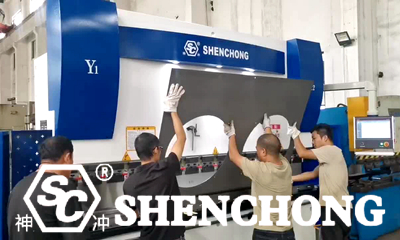
A heat exchanger factory ordered SC CNC Press Brake for heat exchanger cover bending. It has now been delivered to the workshop and is being tested.
Bending of heat exchanger cover is a common processing technology used in the manufacture of heat exchanger shells, especially in shell and tube heat exchangers and some special structure heat exchangers, the cover usually needs to be bent into a specific shape for easy assembly and use.
The bending process must not only ensure the accuracy of the shape, but also ensure the mechanical properties and corrosion resistance of the material. The following are some key considerations and common methods in the bending process of heat exchanger cover.

- SC WSK energy-saving series
- 100Ton 3200MM
- 4+1 Axis
- EL15T CNC Controller
The heat exchanger cover is usually made of metal sheet (such as stainless steel, carbon steel, alloy material, etc.), and its main function is to close and protect the internal heat exchange pipe while ensuring the effective transfer of heat. The bending process mainly involves bending the sheet into a circle or other shape to form part of the shell.
The bending process of the heat exchanger cover needs to achieve the following purposes:
The shape of the cover needs to meet the design requirements to ensure that the heat exchanger can be assembled smoothly.
The bent cover should have sufficient strength to prevent deformation or leakage under working pressure.
For heat exchangers used in some special industries (such as chemical, food, seawater cooling, etc.), the cover needs to have excellent corrosion resistance, so the surface protection of the material must also be considered when bending.
The bending material of the heat exchanger cover is usually a metal plate.
- Stainless steel (such as 304, 316L, 2205, etc.): has excellent corrosion resistance and is suitable for heat exchangers in the chemical, pharmaceutical and other industries.
- Carbon steel: commonly used for general industrial purposes, with good strength and cost-effectiveness.
- Alloy materials (such as titanium alloy, copper alloy, etc.): suitable for occasions requiring higher strength and special corrosion resistance.
During the bending process, the thickness, hardness and other physical properties of the material will affect the process selection and effect of the bending.
When bending, the thickness of the material and the bending radius are closely related. Thicker materials require a larger bending radius when bending, otherwise cracks or material deformation are likely to occur. Generally, the bending radius should not be less than 3 times the material thickness.
During the bending process, the metal sheet will generate internal stress. If the internal stress is not completely released, it may cause deformation or cracks. Therefore, the material needs to be properly pretreated (such as annealing) before bending to reduce the internal stress.
In some cases, the bent part of the cover may need to be welded or connected in other forms. When welding, the quality of the weld must be guaranteed to prevent cracks or affect the sealing. For heat exchangers with high corrosion resistance requirements, surface treatment may also be required after welding to improve corrosion resistance.
During the bending process, the bending angle and dimensional tolerance need to be strictly controlled to ensure that the final cover can accurately match other components (such as tube sheets, flanges, etc.).
For some high-strength materials or key components, heat treatment may be required after bending to remove the internal stress generated during processing and restore the strength and corrosion resistance of the material.
The heat exchanger coverbending process plays an important role in the manufacturing process. Correct bending operation can not only ensure the performance of the heat exchanger, but also improve production efficiency.
According to the characteristics of different materials and the requirements of the product, the manufacturer will choose the appropriate bending method to ensure the high precision, strength and durability of the heat exchanger cover.
At the same time, the bending process should pay attention to factors such as material characteristics, bending radius, stress control, etc. to ensure that the final product meets the design requirements and has good performance.
Shenchong has provided press brake bending machines, plate shearing machines and rolling machines for many heat exchanger manufacturers around the world. SC CNC press brake machine is very suitable for heat exchanger cover bending process. Welcome to inquire!